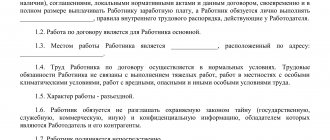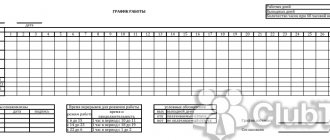11/13/2014 16,576 0 Reading time: 15 min. Rating:
Author
: Konstantin Bely
I have already talked about the different methods of motivating staff and looked at material motivation in more detail. Now it’s time to talk about what non-material staff motivation , what its main methods and directions are, and how best to apply them.
So, if we look at the most common reasons for dismissal, we can see that more than half of employees leave their jobs due to dissatisfaction with the level of pay, but at the same time, up to 40% of employees quit for other reasons, which, accordingly, also need to be paid attention to . All these reasons indicate that the company does not have a system of non-financial motivation for staff or does not operate effectively. Let's look at what it is and how to carry it out correctly.
Types of non-material motivation
An employee who works solely for monetary reward and is completely unaware of praise and intangible rewards probably does not exist at all.
According to Abraham Maslow's theory, every person needs the fulfillment of creative needs, respect and recognition of merit. It is on these needs that the system of non-material incentives for personnel and methods of motivation are built. Depending on the existing corporate culture, the financial capabilities of the company, and leadership style, various types of non-material incentives for employees can be considered. In general, the following types of non-material motivation of personnel are distinguished.
- Social motivation. This includes health insurance, opportunities for training and self-development, and identification of career prospects. The implementation of social motivation involves increasing the employee’s sense of self-worth by involving him in decision-making, participating in team management, and delegating important powers.
- Psychological motivation. Based on each person’s need for communication. It is necessary to motivate non-materially using the method of psychological motivation first of all. Work to create a favorable environment in the team is built taking into account the interests of all employees. Also in this type of motivation, an important role is played by the example and authority of the manager, and the regular holding of corporate events.
- Moral motivation. Addresses the need for respect from the team and company management. The most effective tool is recognition of merit, for which you can use verbal public praise, a board of honor, insignia and certificates.
- Organizational motivation. It manifests itself in caring for the employee, the organization of his workplace, food and rest during breaks in work. This motivational program is usually implemented through the purchase of new office equipment for employee workplaces, the opening of a canteen, and the arrangement of gyms and recreation rooms.
Using the listed types of non-material motivation of personnel, holistic effective systems of non-monetary motivation of employees can be developed, which will necessarily take into account the legal, economic, political and social external conditions in which the enterprise or organization operates.
Motivation methods
And I don’t dare detain you any longer, and we move on to competitive techniques (manipulative and stimulating). I just beg you, introduce at least a couple, otherwise why am I blaspheming in front of you here. Agreed? Okay, I'll continue.
Meaning
Nothing motivates like a common goal. You don’t even have to feed people food if they are united by one global goal.
It can be called differently, but in business it is customary to say the company’s mission. I prefer the word “Meaning”. Test question: “Why are you doing business?” The answers may vary. Someone is betting on “We will prove that Russia can produce the best product in the world.”
Someone creates value at the level of good “Let’s make this world a better place.” And someone carries through the thorns the meaning of the sport: “Let’s increase people’s life expectancy by 2 years.”
It doesn’t matter what exactly you have, the main thing is that people believe in the idea and are ready to give their all.
This is the root of all non-material motivation of employees. This is where I recommend starting to develop this approach, even if it seems relevant only for large companies.
Mentoring
This point cannot be called a direct way of non-material motivation of employees, but it is such.
When an employee has a mentor, he understands that he is cared for. So to speak, a parent (aka friend) is formed within the team, to whom you can always come for advice or just cry into your vest.
By default, the mentor is the superior manager, but here the conversation is less about subordination and more about attitude.
Regardless of whether it is a boss or an experienced colleague, he must work to ensure that the person has an understanding of a strong shoulder nearby, perhaps even in personal matters.
Come here, I will be your mentor
And the same thing works in reverse. If a person is made someone’s mentor, then he begins to feel his importance, which manifests itself in power (which is what many want). As a result, increased motivation without cost. Well, you already understood this without me.
Contest
My favorite method of non-material motivation. Of course, it can be made material, it all depends on the final prize.
But globally, you create conditions centered on the opportunity to show yourself and defeat your opponent. Just like in the famous phrase: “The main thing is not victory, but participation.” Although victory also plays a role here.
I already wrote a whole article about the competition. So don’t be lazy and read, everything is detailed and clear there.
On the subject: Competition for staff: detailed instructions with examples Individual development plan: what is it + examples + template
In short, the ideal duration of the competition is 2 weeks, the prize should be of interest to everyone, and the optimal goal of the competition is to raise the sagging stage of the sales funnel in the company. Read the rest in the article above.
Additional Responsibility
It may seem like a paradox, but the more responsibility a person has, the better he works. This is not an axiom, but it works for some types of people.
The logic is simple: the more responsibility, the more a person feels like an important shot in the company. Especially when it comes to providing additional responsibility of an ordinary employee.
Just don’t take it literally, that tomorrow you need to overload everyone with the most I can’t, and as a result, ask for their mistakes. You just need to add a little more ability to make decisions on your own.
But at the same time, it is important that you do not imaginary give this opportunity, but really trust it and practically do not control it.
By the way. If you want your employees to sell better, I recommend implementing scripts. For example, start with templates. We developed them for different tasks based on our experience (8+ years). The investment is a penny and will pay off in a matter of days. Click -> Sales script templates.
Height in width
I want to write again that this is my favorite example of non-material motivation, but in order not to repeat myself, I will say that it is fundamental to any company.
The point is that you do not raise the employee’s position along the vertical axis (manager -> department head -> director -> so on), but do it in width. The most classic example: manager -> senior manager -> group senior. Depending on the category, the employee will have additional privileges compared to everyone else.
And in developing the system, I would rely on an intangible asset. For example, a softer chair, an extended lunch window, or the opportunity to be the first to choose vacation dates.
Space
After the appearance of a soft corner in the company, employees began to stay late at work more often. I can't say that this is good news from an environmental point of view.
But on the other hand, since they stay longer, it means they want and enjoy doing it. And the soft corner is just an additional incentive.
We are also talking about the workspace. And I clearly noticed this when one of our clients could not find new employees for his company until he equipped a modern office with all the amenities for his sales managers.
No, it wasn't Google. But in comparison with the previous room, this at least did not cause disgust.
Present
My partner has this type of non-material motivation for staff since birth.
When he goes to work, he can buy a couple of cakes, a few pizzas or other gifts for the whole company. But if he is used to doing this, then you can do it consciously to raise the morale of your colleagues.
Moreover, gifts can be given both without a reason and with a reason. From the banal, this is a birthday, New Year, March 8, February 23.
I recommend not saving on this. And as a smart owner, immediately factor these costs forward into the salary of each employee. Of course, they shouldn't know about this.
Education
This way you kill two birds with one stone: train your employees and increase sales.
Training can be carried out both within the company and sent to study with renowned trainers. Naturally, the second option affects the level of respect in your favor several times better than local education.
If you want to get the maximum in the form of non-material motivation for your staff, then also periodically send your employee for training, but this time for a hobby.
Believe me, you will see a pleasant shock in the eyes of your people from the fact that the company cares about them not only as a team member, but also as an ordinary person.
Working conditions
I will split this point into several, since it can be viewed from different angles.
Conceptually: You need to create conditions that will be an added value when applying for a job. Among the most pronounced and not always obvious applications, I highlight:
- Nutrition;
- Directions;
- Treatment;
- Insurance;
- fuels and lubricants;
- Cellular;
- Lunch nap.
Logically, this also includes space, but I took it out separately because I think that in our time this requires special attention. But at the same time, you can also safely include the work schedule, official employment, and the date of payment of salaries. In general, everything is now more understandable for the manager.
Events
This is when you get together as a team and have fun. Everything can happen under the guise of an ordinary corporate party in the form of a feast.
Or maybe in a team building format, where the whole friendly crowd competes against each other in a playful manner. Ideally, combine both to tap into different pleasure zones.
But remember that if you do not have the most friendly team (for example, everyone works on different shifts and does not overlap), then without proper preparation such events can become hard labor, not pleasure.
I'm sure each of us has been to such meetings from which we want to quickly escape. So, it’s better not to do this at all.
Best employee
This is a logical continuation of the points “Growth in width” and “Competition”. Only here we are not talking about issuing privileges not based on achieving a career ladder, but based on the results of the monthly nomination “Best Employee of the Month.”
This is a separate point, since this cannot be called career growth, and it does not qualify for a competition, since it is launched on an ongoing basis.

The best employee is me
Based on the results of each month, you can issue different incentive privileges. My favorites: the ability to choose a work schedule (with a variable schedule) and additional days off.
In general, here the choice of a prize is tantamount to consistency, as in holding a competition for staff. But for your convenience, I will summarize it below.
Other name
Now you will laugh for a long time, but this simple action also applies to non-material ways of motivating staff.
Again, briefly: You rename the employee's position to something more pleasant and authoritative. For example, not a secretary, but the owner of the office. Or not a manager, but a seller of happiness.
Moreover, you can go through positions, departments, and premises. And the effect of such a non-standard method will not take long.
Because it’s much more pleasant to tell clients that you are not the head of the sales department, but the genius of the sales department. And there will be a reason for conversation, and at the same time the position sounds more respectable.
Motivational board
The ideal intangible motivation for a sales team is an achievement board. You publicly post a board in the office where you daily note the results of each employee for the previous day and by month.
This way you constantly maintain a competitive environment throughout the department. And at the same time she is quite healthy.
For advanced companies, I recommend automating this process by outputting data directly from a CRM system (for example, Bitrix24 or Megaplan) to a TV.
This is especially true when a sufficient number of applications are received per day and the results of the championship can change every hour. Doing this is not as difficult as it seems.
Gratitude to mom
Have you ever said “thank you” to the parents of your employee?! Most likely no. This is normal, since the practice is not obvious, but it is very effective.
Task: take and give anything (even money) to your employee’s mother. This way you will do a good deed, show your best side and, most importantly, you will call your parents to your side (and their opinion is very important for children).
But please note that we are talking specifically about mom. We tested praise for dad, but they somehow react with restraint and don’t give a wow effect.
In the case of mothers, everything happens very brightly and effectively. All this was assessed based on feedback from the employees themselves after their parents told them about the gift.
Personal
This is something we do every day, but often don't notice. And since this is also an intangible method of motivating staff, it is better to use it consciously.
It's about personal and human communication. You can manifest it in dozens of different ways, I’ll show you a few for understanding:
- Give praise after work;
- Conduct a personal meeting for “life”;
- Shake hands;
- Sitting in an open office;
- Call and find out how you are doing.
Moreover, the closer the superior employee communicates with the inferior one, the better for the second one.
This breaks down a certain glass wall between positions. And of course, you cannot completely switch to personal communication, as the chain of command will be disrupted. But a little of this behavior will add more life to each employee.
On the subject: How to communicate with subordinates: 70 tips from practitioners
Methods of non-material motivation of personnel
Each company can create and apply its own methods of non-material incentives for staff. The set of motivating tools will depend on the nature of the team, the specifics of the work, and the management style.
For example, a team of young and active professionals can perfectly motivate spending leisure time together (picnic, group hike, corporate holiday, participation in sporting events). While for representatives of the older generation, the opportunity to get additional vacation days or a family trip to rest.
The most effective methods of non-material incentives for personnel are as follows:
- provision of paid time off, additional vacation days;
- providing flexible schedules to employees;
- awarding tickets for cultural events, tourist vouchers;
- organization of corporate events;
- employee training;
- personal public praise;
- organizing competitions and quests among all employees;
- drawing up career development plans for employees (it is necessary for the employee to know that upon reaching a higher professional level he will be promoted);
- possibility of continuous professional development;
- congratulations to employees on significant dates (anniversaries, weddings, birth of a child);
- creating comfortable working conditions;
- providing greater freedom of action in performing assigned tasks;
- holding motivating meetings;
- involving employees in decision making;
- incentive trips;
- informing the team about the employee’s achievements;
- assistance in family matters (for example, provision of transportation when moving);
- providing discounts on company services;
- possibility of additional part-time work;
- beautiful job title;
- seeking advice from employees;
- organizing meals for employees, gyms or providing memberships to sports clubs;
- organizing the opportunity for a personal meeting with senior management.
This is not a complete list of ways to non-materially motivate staff for work achievements without direct payment of cash bonuses or salary increases. Such methods, as a rule, affect the entire team of the enterprise as a whole, which has a much greater effect on the material motivation of the most successful employees.
Forms of non-material incentives
Non-material incentives for employees can be provided in various forms. Forms of non-material incentives include:
- partial payment of the needs of the employee and his family members;
- career advancement;
- public encouragement;
- organizing more comfortable working conditions for the employee.
Examples of non-material incentives for staff:
- assistance to the employee in paying for training, purchasing housing, treatment, paying for a gym membership, vouchers to a sanatorium, etc.;
- enrollment in the personnel reserve, involvement in solving issues of organization management - inclusion in the collegial management body (centripetal career), assignment of functions of a consultant, advisor on various issues;
- inclusion on the organization’s Honor Board, awarding the title “Best in the Profession,” awards for memorable and corporate dates, praise, introducing the employee to senior management, etc.;
- providing a better workplace, better parking space, more convenient working hours (flexible working hours, remote work), preferential right to choose vacation time, etc.
Non-material incentives in municipalities, government organizations, and joint-stock companies can take different forms. They have one goal - to encourage the employee to work better, with higher quality, with maximum efficiency, not only for the sake of money, but also for the sake of some idea. What kind of idea will motivate an employee is decided individually in each specific organization.
Non-material incentives can be schematically presented in the form of the following table.
| Non-material incentives | ||
| Moral | Social | Creative |
|
|
|
System of non-material motivation of personnel
Employee motivation will have the greatest effect through systemic action. A clearly established system of non-material motivation of personnel should become part of the corporate culture. At the same time, the system should be as open as possible, which will enable the employee to know what support the company provides for loyal employees.
When developing a non-material incentive system, the following factors are taken into account:
- The motivation system should focus on the development of the most significant areas of the company’s work.
- The motivation system involves all employees of the enterprise.
- The incentive program should be subject to periodic review and updating.
- For the system to work effectively, it is necessary to identify the needs of all employees and “adjust” approaches and incentive tools for each group.
Another important requirement for the current system of non-material incentives for personnel is documentation. This significantly increases its transparency and allows each employee of the enterprise to become familiar with the motivation system. When developing a project for non-material motivation of personnel, it is necessary to involve specialists from the HR department and line managers. Only this method will make it possible to obtain real, most effective tools for influencing employee productivity.
Non-material motivation of employees results in certain costs for the enterprise. But in total they provide a much greater effect than the costs of direct payment of premiums. An additional success factor is the selection of personnel with internal self-motivation. It is easy to “tune” such employees to maximum efficiency and high loyalty to the company. Energetic, active and proactive employees are the key to success, therefore a well-structured system of personnel incentives is the most important task of personnel policy.
Principles of building an incentive system
The formation of a non-material incentive system should be based on certain principles:
- It must be remembered that the purpose of stimulating personnel is to encourage them to achieve the goals facing the organization, therefore, labor behavior should be encouraged that allows them to achieve the goals set for each employee, his department and the organization as a whole.
- The incentive system should be simple and understandable to employees so that they can trace a clear connection between the results of their work and the rewards they receive. It is necessary to strictly regulate the procedure for assessing labor results and the procedure for providing a motivational package.
- It is recommended to differentiate bonuses depending on the category (status) of employees, as well as provide them with the opportunity to choose so as not to waste the organization’s funds - the so-called “cafeteria principle”.
- The incentive system should not be created once and for all. The goals of the organization change over time, and accordingly, the motivation system must respond to this. Flexibility and adaptability are the key to success.
- The methods of non-material incentives for employees used in the organization must comply with the law. For example, placing a photograph of an employee on the Honor Board must be carried out in compliance with the legislation on personal data.
- It must be remembered that any events that we call “intangible” result in certain expenses for the organization (well, except perhaps for words of gratitude). Therefore, calculating the economic efficiency of non-material incentive methods is mandatory: suddenly it turns out that the costs are unaffordable for your organization.
Key goals of non-material motivation of employees

The desire to be realized in a particular activity is a key motive that allows you to work as fruitfully as possible. An employee interested in the result does not look at his watch waiting for the end of the working day; his goal is to achieve success today and every day. It is wrong to think that only material benefits can stimulate the performance of employees. Non-material motivation of the team is no less important.
Non-material motivation is understood as a system of management actions aimed at encouraging employees without the use of bonuses and salary increases. Often these actions become the most effective tool for managing team work. The use of various methods of non-financial motivation makes it possible to reach a whole group of employees, and the effect of the measures taken is maintained for a long period.
A set of actions aimed at increasing the productivity of the team pursues several goals:
- support and development of team spirit;
- stimulation of a creative approach to work;
- increasing the number of loyal employees;
- increasing the performance of each team member;
- mastering new knowledge and skills;
- maintaining a friendly atmosphere while maintaining healthy competition.
Non-material motivation in an organization has a beneficial effect on the work of the entire team, supports corporate spirit, and convinces of the need for teamwork. The main task of such encouragement is to create a favorable atmosphere so that each employee feels like an important and necessary member of the team, acting in both personal and common interests.





